Malaysian physics and the maker ethos
DOI: 10.1063/PT.3.5175
Although the first physics department in present-day Malaysia was founded only in 1961 at the University of Malaya (UM), the country began its foray into modern physics in the mid 1950s, at the same time that it was beginning to form a national identity. That was a complicated process: The Federation of Malaya achieved independence from the UK in 1957 and united with three other former UK colonies—Singapore, Sabah, and Sarawak—to form Malaysia in 1963. (Singapore agreed to a separation in 1965 and is now an independent city-state.)

The Petronas Twin Towers form the centerpiece of the famed skyline of Kuala Lumpur, Malaysia’s capital. (Photo by Sean Pavone/Alamy Stock Photo.)
ISTOCK.COM/ELENAMICHAYLOVA
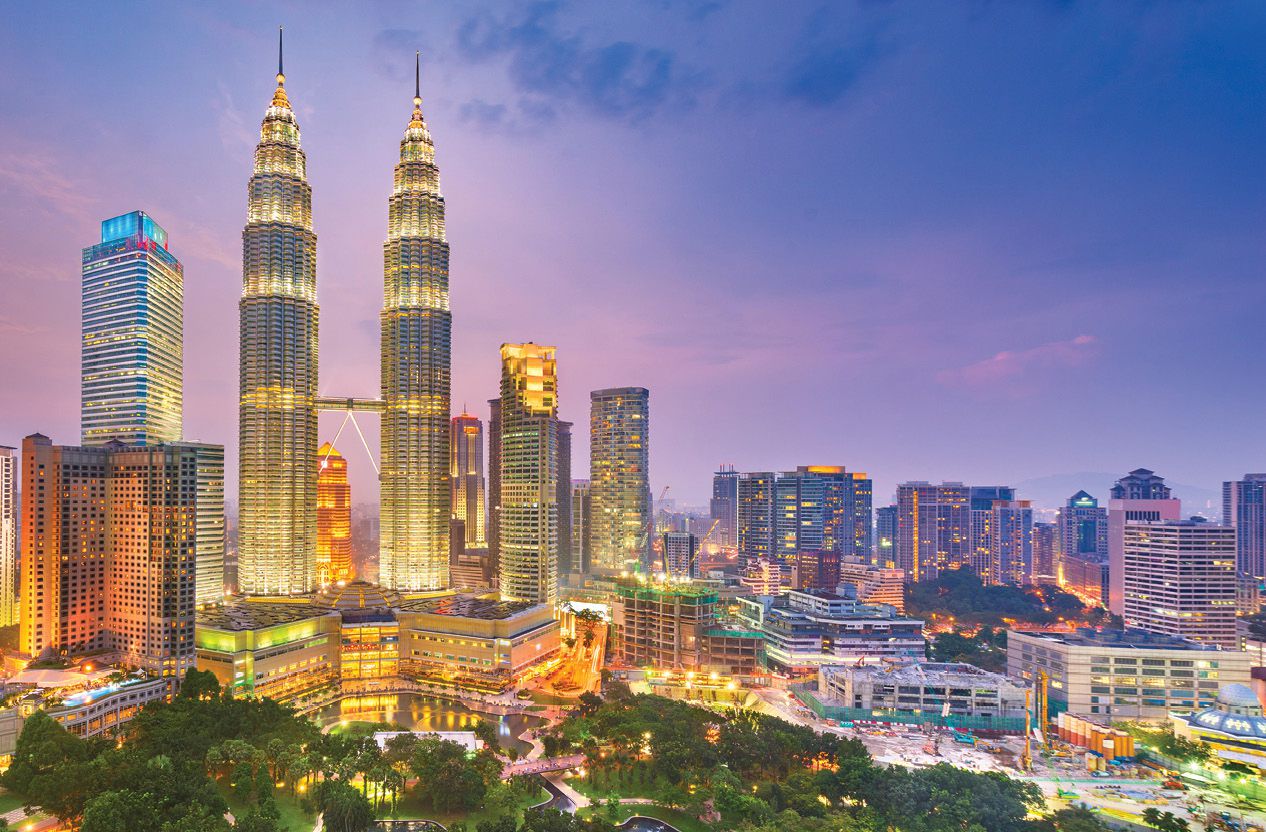
UM, the country’s first university, was founded in 1949 when colonial officials merged the King Edward VII College of Medicine with Raffles College. With the university, they hoped to provide a common Malayan identity that would represent a compromise between the colony’s different ethnic groups. 1 That compromise began to take shape after the 1942–45 Japanese occupation during World War II, when the UK returned to a politically changed territory that was suddenly less subservient to its colonial policies. Surviving records of student activities during the eight years before Malaya’s independence in 1957 illustrate increasing nationalist and political agitation on UM’s campus.
For UK administrators, the university was to be the diplomatic link between the new administration of an independent Malaya and the UK. Science was seen as a neutral ground devoid of political undercurrents: Malayan scientists seem to have rarely participated in anticolonial protests, nor did they appear to engage in other forms of political activism. The apolitical nature of the Malayan scientific enterprise contributed to a culture that increasingly valued empirical research over work that was more philosophical. Academic science departments were set up to both carry out bread-and-butter goals and deal with nation building in “administrative, legal, and economic systems.” 2
The lack of a clear connection between philosophy and science shaped a more pragmatic attitude toward physics. But that did not translate into the straightforward approach of “shut up and calculate” because the limited resources available in Malaysia meant that physicists needed to find ways around knowledge black boxes. That need gave birth to the “maker ethos,” a term scholars have coined to describe do-it-yourself cultures and practices of crafting, fabricating, and repurposing technologies for everyday applications. In maker cultures, people of diverse backgrounds come together to nurture hands-on solutions and bring social values into the practice and circulation of knowledge. In so doing, they offer a counterargument to the widely held idea that technology alone determines the path of history. 3
The maker-ethos framework enables scholars to understand how different and seemingly antithetical practices from varying scientific knowledge traditions—modern Western physics and medieval astronomy in the case of Malaysia—can coexist. It explains how Malaysian physicists connected local needs with the international community and how the government’s call for “technological action” became the impetus to encourage the pursuit of medieval astronomy, which was deemed suitable to fulfill a religious ritual important to the country’s Malay Muslim community: the observation of lunar phases to properly determine the start and end of the fasting month, Ramadan.
Physics from the ground up
Beginning in the late 1920s, well before the first physics department was established at UM, selected schools in pivotal centers of the Malayan colony started offering rudimentary physics courses as part of basic science education. Aside from that, physics was taught on a need-to-know basis. Starting in the late 19th century, for example, doctors and clinicians began receiving training in basic physics principles, which were necessary for handling medical x rays and radioisotopes
4
(see figure
Figure 1.

A reproduction of the first x-ray photograph made in present-day Malaysia. The image, taken in 1897, is of a pomfret fish. (Courtesy of Mohd Hafiz Mohd Zin and the Science University of Malaysia.)
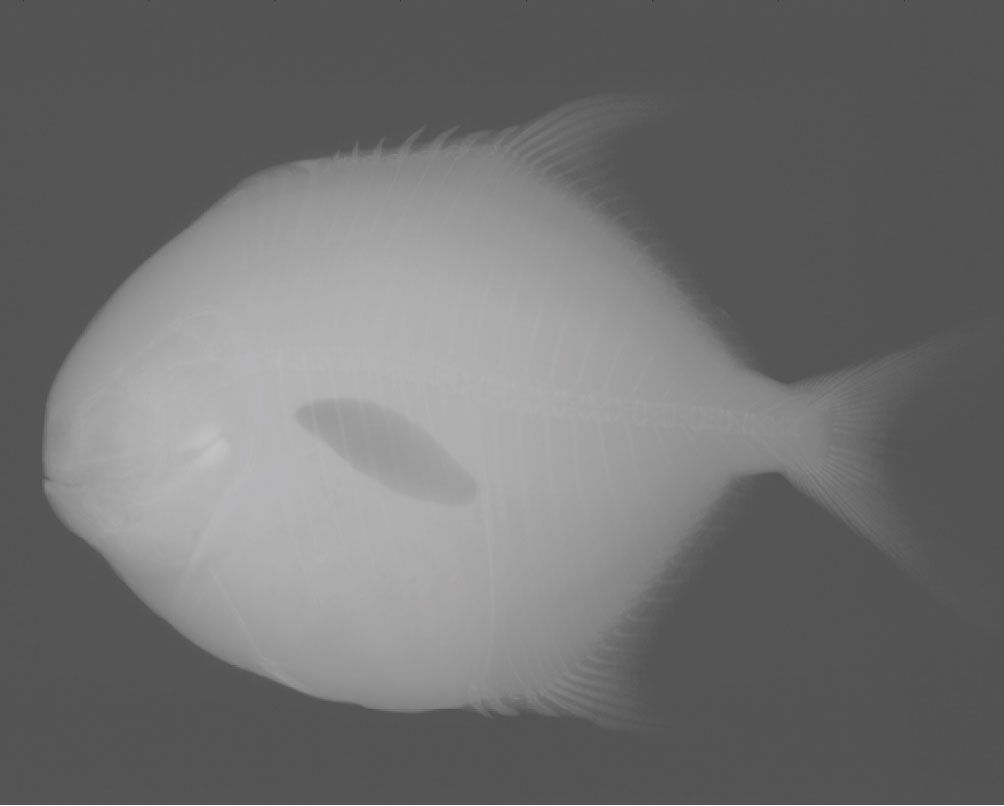
The establishment of UM did not happen in a vacuum: It was one of several research institutions set up by colonial authorities that aimed to reap economic benefit from basic science. Before modern Malaysia was formed with its current borders in 1965, Malayan physicists primarily collaborated with their former PhD advisers in the UK and Australia or participated in international collaborations, such as the International Geophysical Year of 1957–58 with UK assistance. 5 Only in the 1970s did Malaysian physicists begin to spend time doing research abroad.
By that time, Big Science was taking off in more resource-capable countries. Like other postcolonial nations, Malaysia focused on tabletop experimental physics, which remained crucial to facilitating both applied and exploratory research. As it grappled with how to fund research on a limited budget, the country began to face the famous tension between basic and applied science. 6 At first the divide was not so pronounced, but by the 1980s, budget cuts at universities led to increased pressure to develop research that could support itself through private and industrial funding.
Physics and industry
By 1965, newly trained Malaysian physicists who had received their PhDs abroad were starting to return home. One of those individuals was Thong Saw Pak, who spent time in China in the late 1950s as a postdoctoral researcher before becoming the first chair of the department of physics at UM’s campus in Kuala Lumpur. (Before Singapore’s secession in 1965, the university had two campuses: one in the present-day city-state and one in Kuala Lumpur. The former is now the National University of Singapore; the latter is modern-day UM.) In a 1962 lecture, Thong argued that physics contributed to technological advancements and improvements in quality of life. For him, physics was central to industrialization. Similar lines of thought were in a 1966 speech given at UM by Karl Emeléus, a visiting physicist from Queen’s University Belfast. 7
Both speeches illustrate how the bridge between basic science and technology stemmed from a philosophy that prioritized inventiveness as a way to best achieve development goals. That made poorer, postcolonial states dependent on wealthier states, because richer countries sought to cultivate knowledge producers who would create proprietary science and technology that would benefit foreign investments. It also implicitly allowed wealthy states to dictate which research programs were valued and prioritized. 8
Making physics
In the 1960s plasma physics was seen as the bridge between theoretical quantum physics and the needs of industry. And plasma physics required equipment that could be used in other, related areas of physics that were also in vogue at the time, such as nuclear, radiation, and ionospheric physics. For that reason, Malaysia began to develop expertise in particle, laser, and condensed-matter physics in the 1970s and 1980s. Because the country had few physicists and only three universities with a physics department—UM, the National University of Malaysia (UKM), and the Science University of Malaysia (USM)—it was unsurprising that scientists prioritized research programs that straddled multiple fields and, in the case of experimental and applied physics, allowed them to reuse available equipment (see figure
Figure 2.

Scarce resources often forced Malaysian physicists to reuse or repurpose old laboratory equipment. This image depicts a closet full of old apparatus at the Science University of Malaysia that dates from the university’s early years.
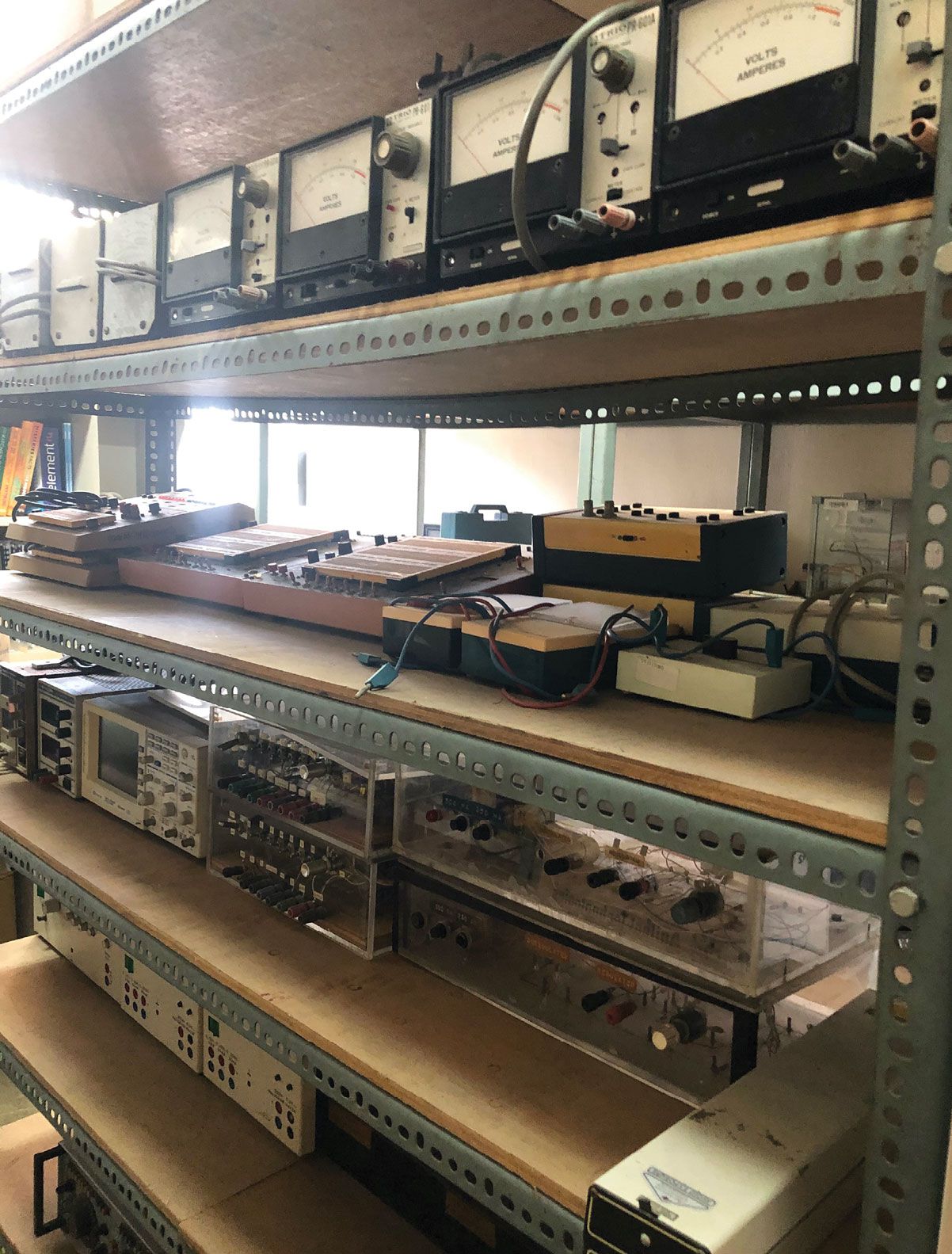
In terms of the number of trained Malaysian experts available, plasma physics, nuclear physics, and—by the 1980s—laser physics dominated. With the assistance of the United Nations University in Tokyo, which facilitated research training, experimental physicists from UM were at the forefront of fostering collaboration between developing countries by training physicists from Egypt, India, Indonesia, Nigeria, Pakistan, and Sierra Leone. The Malaysian scientists taught them how to plan and design methods for developing their own experiments that would contribute to their national research programs. Doing so involved balancing costs, matching instruments with each country’s research and teaching programs, and considering how equipment might be adapted for research in related subdisciplines.
After receiving startup funding, the physicists were responsible for deploying their newly gained technical knowledge in their home countries (see the article by Sing Lee and Chiow San Wong, Physics Today, May 2006, page 31
Between 1949 and 1960, physicists at UM’s campus in Singapore pursued tabletop research in ionospheric and nuclear physics. Making use of instruments and data from the colonial period along with some equipment they were able to purchase, they focused largely on measurement and calibration studies. Some of their publications during that period demonstrated how cosmic-ray studies in atmospheric physics, for example, could be readily transferred to plasma physics.
Because most of them had not trained with physicists with established research programs in then-new subfields of physics, such as relativity theory and quantum mechanics, the first generation of Malaysian physicists was largely unfamiliar with those topics. For that reason, the research they conducted typically focused on reproducible research that was likely to be pedagogically and industrially useful. Those physicists also had to ensure that they were sufficiently trained with instruments so that they could help set up the laboratories for the new universities established from the 1960s onward, such as UKM and USM.
The maker ethos helps scholars understand all the above phenomena, especially Malaysian physicists’ backgrounds, their choice of research programs, and the international collaborations they established. Although the networks of scientific exchange that were set up in the colonial and early postcolonial periods had involved other physicists from the Commonwealth of Nations, by the 1970s they expanded to include physicists in other developing Southeast Asian countries, such as Indonesia and the Philippines, and those in newly industrialized East Asian countries, such as Japan.
Published proceedings from regional physics conferences from the 1970s onward provide a glimpse into the tension between science that prioritized matters of domestic importance and science seen as having more international panache. They show that what counted as physics was not parceled out in neat terms—the maker ethos that underpinned the development of scientific knowledge meant that the type of scientific orthodoxy that privileges only certain topics as a legitimate focus for physics research did not exist in the postcolonial Southeast Asian context.
Experiment or theory?
Under the maker ethos, the distinction between theory and experiment is blurred. Malaysian plasma physicists of the 1970s saw themselves as contributing to research on nuclear fusion through their experiments. Malaysian experimentalists did work with local theorists—at the time, USM already had a small program in theoretical plasma physics—to ensure that their experimental designs were rigorous. But their mathematical scaffolding was still limited and largely used to mediate between an analytical conceptual framework and numerical methods.
Not all theoretical work was done to aid local experimentalists, however. Starting in the late 1970s, a small group of Malaysian theorists who worked mainly on particle physics began to consider smaller research questions foundational to problems in that field. Their work helped clean up some of the paradoxes in larger physics models.
Through interviews, I have learned that physicists of that generation (see figure
Figure 3.

A 1974 group photo of the University of Malaya physics department, including professors, staff, and students. (Courtesy of Sing Lee.)
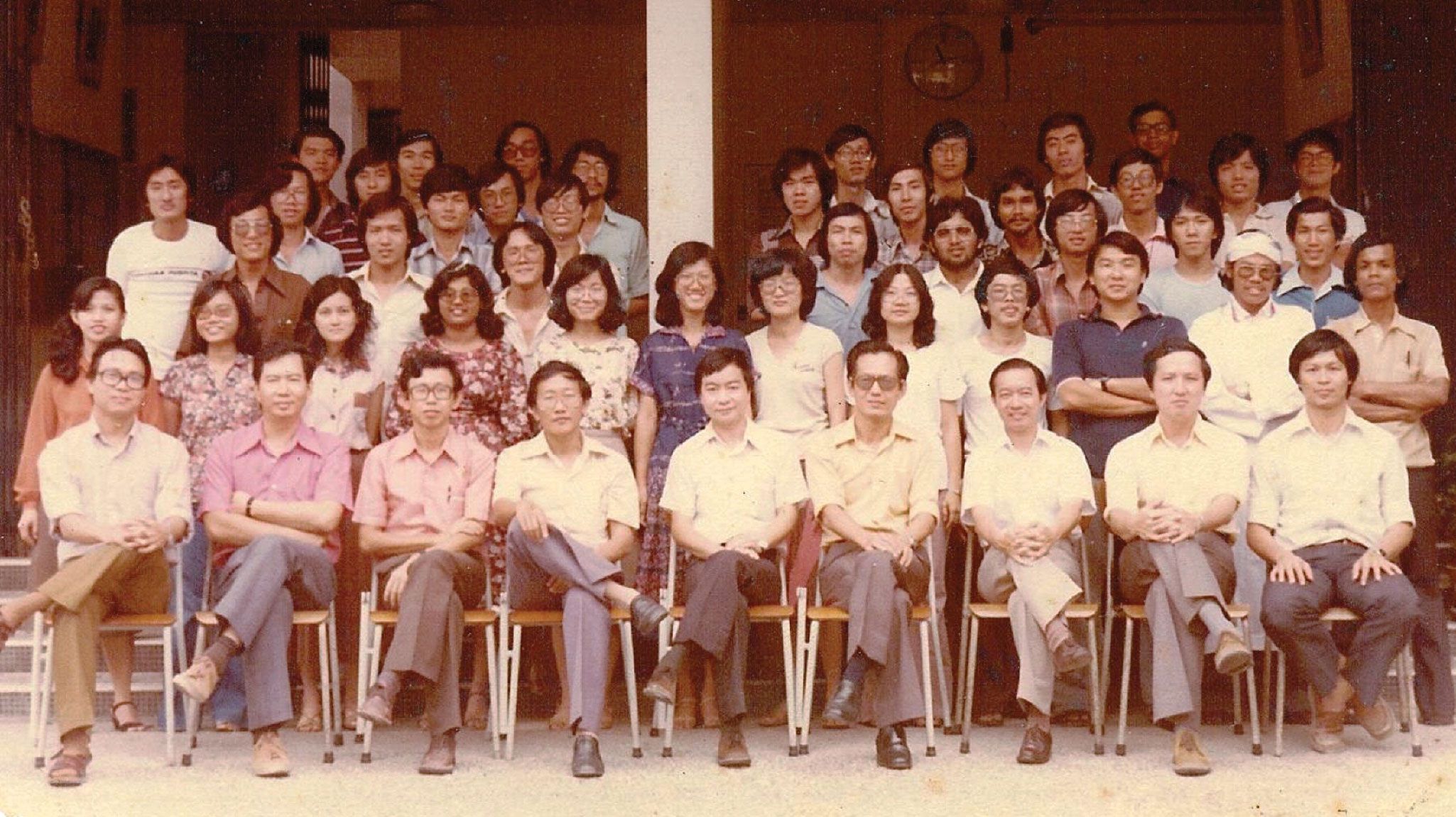
Until the 21st century, Malaysian universities didn’t have any experimental research groups in particle physics, so, as I’ve learned in interviews, experimentalists either joined collaborations in other countries, including West (and, later, reunified) Germany and Japan, or took on other projects where they could deploy their skill sets. Funds for traveling abroad were minimal, so Malaysian physicists began serving as experts in technical-assistance programs or applied for scholarships from such funding sources as Colombo Plan scholarships and the UK’s Commonwealth Scholarships.
Unlike the first generation of Malaysian physicists, who were able to carry on the research programs they had trained in despite resource limitations, younger physicists trained abroad found it increasingly difficult by the late 1980s to continue their research upon their return home. That meant that physicists who trained elsewhere often chose not to return to Malaysia to avoid disrupting their career; the resulting brain drain contributed to discontinuity in the generational flow of physics research.
Although Malaysia had no formalized national policy regarding science and technology before 1985, its annual national development plans included provisions to fund recruitment and training of Malaysian scientists and to build scientific infrastructure. The physicists saw their research as an opportunity for economic and social advancement: Several of the third-generation physicists trained in the 1970s and 1980s came from working-class backgrounds. Most of them were men, but some were women, including the theoretical physicist Rosy Teh (who spent six months as a postdoc at CERN). Because physics was viewed as a service to the nation, domestic accomplishments were seen as more worthwhile than recognition abroad. That tension can be seen in the arguments made by physicists themselves, who believed that Malaysian physics should be more focused on economic development than driven by curiosity. 9
Scarce resources and limited infrastructure required Malaysian technical experts to inventively adapt or reconstruct equipment,
10
which meant that scientific research involved crafting, hacking, and repurposing (see figure
Figure 4.

A diffusion cloud chamber, at left, homebuilt by Andrew J. C. Chong, a Malaysian physicist. At right is a close-up of the object in the chamber: a small piece of the mineral thorianite. Under the influence of the chamber’s magnetic field, the thorianite emits alpha particles (thick, straight, short lines) and beta particles (thin, curvy, faint lines). (Courtesy of Andrew J. C. Chong.)

Nevertheless, the sciences, including physics, were relatively meritocratic in their recruitment and retention of talent during that time. Although Malaysian physics was at first dominated by ethnic Chinese, that began to change with the founding of UKM in 1970. That institution was set up to overcome the shortage of ethnic Malay technical experts through recruitment and training, and its establishment began the gradual shift of the language of science instruction from English to Malay. Aside from language courses, Malay is now the sole language of instruction at UKM, although English is being gradually reintroduced to appeal to international students.
Given the lack of local scientists who were able to teach science in Malay at a high level, Indonesian scientists were brought in to fill the gap well into the 1970s. The Malaysian government also recruited and sent bright Malay students for training abroad under its New Economic Policy, which led to an increase in the number of ethnic Malay physicists by the mid 1970s. Later in the century, merit-based affirmative action gave way to increasingly racialized policies in the civil service that privileged Malays over other groups and contributed over time to the Malayization of the public university system and a decrease in scientists from other ethnic groups.
Anachronistic knowledge
One might assume that there would be no connection between indigenous Malayan and Malaysian knowledge traditions and the modern physics introduced into the country in the 20th century. But some in Malaysia argue that the practices of scientific knowledge under the auspices of Islamic beliefs are concomitant with modern Western physics. One such example is ilmu falak, or Islamicate astronomy and astrological divination, which are touted by their advocates as being representative of the scientific traditions of the Malay world. In Malaysia, astrological divination is still taught in the sekolah pondok, a traditional type of Malay school roughly equivalent to the US one-room schoolhouse. In such schools, students from varying age groups are taught recitation-style by religious teachers. 12 Those schools predate the colonial era and still exist today. They serve mainly as a supplement to the secular school system.
Although the theoretical and practical knowledge—including a heliocentric view of the universe—that those schools taught would be considered legitimate from the perspective of modern physics, the material drew heavily on premodern and early-modern astronomical knowledge.
13
That would not change in the 1980s, when modern astronomy began developing as a field in Malaysia. Religious teachers taught not only theories but also methods of constructing handheld instruments, such as astrolabes that used the lunar calendar to determine dates and times for the performance of religious rituals (see figure
Figure 5.

A modern-day astrolabe constructed by Jacopo Koushan in Iran in 2013. Similar instruments are still constructed and used by members of the Malay Muslim community to assist in such religious rites as the determination of prayer times and the direction of Mecca. (Photo courtesy of Masoud Safarniya, CC BY-SA 3.0
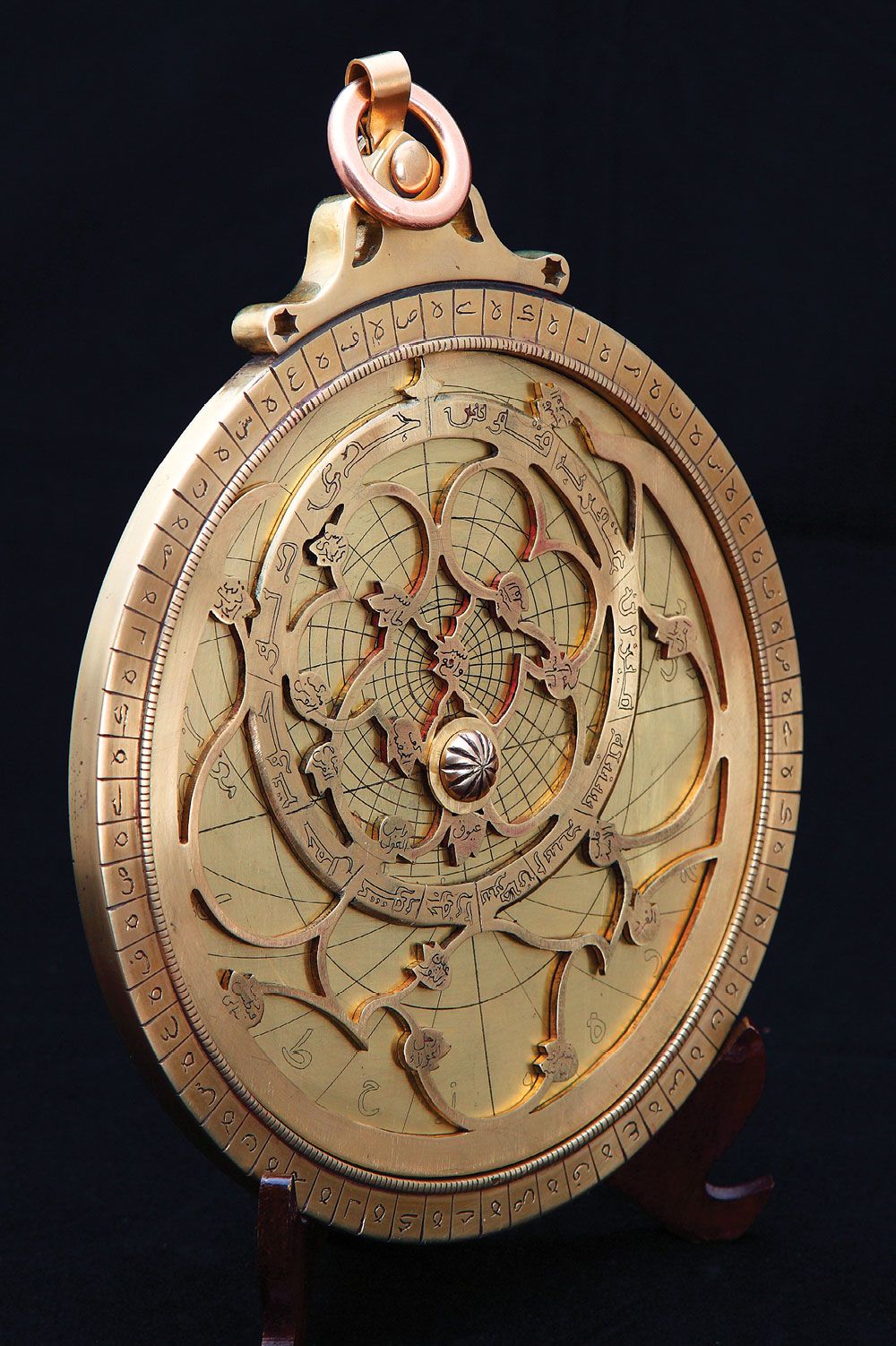
That type of learning can be understood through the maker-ethos paradigm because even though religious teachers at pondoks had limited training in mathematics and the sciences, they made a concerted effort to render accessible to nontechnical experts the calculations and measurement techniques that could be used to calibrate calendrical events. Most of that knowledge was derived from religious texts of varying levels of technical detail.
Because many medieval astronomy texts were written in Arabic, they were orally translated by teachers who could read and understand the language. The translation was faithfully written down by their students, who then compiled the notes into collections. Teachers with requisite Arabic knowledge were spread across colonial Malaya, so it was not unusual for more-senior instructors to correspond with younger colleagues on problems requiring technical resolution. In other words, those religious teachers and their pupils hacked scientific knowledge to create useable technologies that enabled themselves to fulfill their religious obligations.
Moreover, that knowledge was not indigenous to the Malay community but was localized to meet its needs. Although traditional astronomical knowledge is no longer taught in religious schools, Islamic-studies departments across Malaysia still teach it. Even if their university has a physics department, Islamic-studies scholars often don’t interact with secular physics faculty, although some Muslim physicists occasionally get involved with traditional astronomical work because they are interested in it and therefore contribute their technical knowledge to the collaborative endeavor.
Compared with the more transnational way in which Islamicate astronomy knowledge was transmitted in the mid 20th century, much present-day Malaysian research in that area has become isolated from studies of Islamicate sciences elsewhere. Nevertheless, the fact that Islamicate astronomy, divination, and astrological studies coevolved with secular physics departments in the 1950s and 1960s despite appearing to have no relationship to each other is representative of the plural forms of modernity in existence.
Modernism and physics knowledge
Early-20th-century physics often served imperialist aims: Practitioners who were trained in university laboratories in imperial metropoles such as the UK, France, and the Netherlands would subsequently serve the needs of colonial administrators by finding permanent appointments in various institutions. 14 Colonial officials encouraged the development of astronomy because methods used to stargaze and canvass terrestrial sites could also be used to survey uncharted lands. That was also why imperial officials encouraged the development of meteorology and geology in the colonies and fostered the establishment, for example, of local weather bureaus. The fields of science that were allowed to develop in the colonies were not just following global knowledge trends but often steered by external political interests. For instance, even though the UK established several sites for astronomy research in colonial Malaya, modern astronomy and astrophysics were never included among key physics subfields in Malaysia until UKM inaugurated the beginnings of a space-studies center in 1990. A national planetarium 15 wasn’t established until 1994.
Malaysian physicists did not partake in the early-20th-century philosophical debates that forged the idea that classical and quantum physics were separate knowledge systems. As far as they were concerned, all physics was modern. 16 During the 1950s and 1960s, experiments carried out by local physicists were simple. They focused on replicating measurements, collecting data based on others’ experimental designs, and designing experiments that would enable them to test newly acquired or newly built apparatus. The knowledge gained from those investigations was then transferred to local technological and industrial needs. By the 1970s, physicists began supplementing their studies with basic-science experiments in such subfields as nuclear and condensed-matter physics.
Modern physics can be considered to be part of the postimperial postwar order, which aimed to ensure the continued dominance of states with global influence, whose arsenal of scientific knowledge would be bartered with emerging states in the guise of economic development and industrialization. The astronomy of the Malay Muslim community stood apart from that phenomenon. But even though they had different goals, both Islamicate astronomy among the Malay Muslim community and modern physics embodied the maker ethos. In both instances, the maker ethos was crucial to the intellectual confidence of Malaysian physicists, who were beginning to form professional and cultural identities. It allowed them to carve a path for themselves despite their complicated political situation. That same spirit would influence the development of Malaysian physics from the 1980s onward.
References
1. A. M. Carr-Saunders, New Universities Overseas, George Allen & Unwin (1961), p. 57.
2. Commission on University Education in Malaya, Report of the Commission on University Education in Malaya, His Majesty’s Stationery Office (1948), p. 10.
3. S. Nascimento, A. Pólvora, Sci. Eng. Ethics 24, 927 (2018). https://doi.org/10.1007/s11948-016-9796-8
4. M. R. bin Hashim, in Centennial of the X-Ray: An Account of Developments in Radiological Physics and Radiology in Malaya and Malaysia, A. A. Tajuddin, D. A. Bradley, eds., Malaysian Institute of Physics (1995), p. 1.
5. “Colony’s role in world’s biggest research project; all eyes (scientific) on skies this year,” Straits Times, 14 February 1957, p. 6.
6. G. Gooday, Isis 103, 546 (2012). https://doi.org/10.1086/667978
7. K. G. Emeléus, The Role of Physics in Industrial Development and Other Lectures, U. Malaya (1966).
8. M. A. Ynalvez, W. M. Shrum, in International Encyclopedia of the Social and Behavioral Sciences, 2nd ed., vol. 21, J. D. Wright, ed., Elsevier (2015), p. 150.
9. C. Singh, in Peranan fizik dalam negara membangun/The Role of Physics in Developing Countries, National U. Malaysia Department of Physics (1979), p. 25.
10. K. H. Ong, in ref. 9, p. xi.
11. S. C. Lim, in ref. 9, p. 18.
12. A. A. Mat Zin, in Sejarah astronomi Islam di Malaysia (History of Islamicate astronomy in Malaysia), A. A. Mat Zin, ed., U. Malaya Press (2016), p. 17.
13. N. Ahmad Zaki, in ref. 12, p. 27.
14. L. Pyenson, Empire of Reason: Exact Sciences in Indonesia, 1840–1940, E. J. Brill (1989).
15. Z. Z. Abidin, M. F. Asillam, J. Y. Koay, Nat. Astron. 4, 1115 (2020). https://doi.org/10.1038/s41550-020-01230-x
16. R. Staley, Isis 96, 530 (2005). https://doi.org/10.1086/498592
More about the Authors
Clarissa Lee is a junior fellow at the RWTH Aachen University’s Käte Hamburger Kolleg: Cultures of Research in Aachen, Germany. Her work focuses on the philosophy, sociology, and history of science, technology, and media in Southeast Asia.

